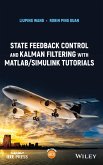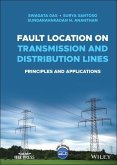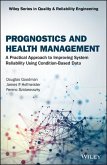- Broschiertes Buch
- Merkliste
- Auf die Merkliste
- Bewerten Bewerten
- Teilen
- Produkt teilen
- Produkterinnerung
- Produkterinnerung
The text material evolved from over 50 years of combined teaching experience it deals with a formulation and application of the finite element method. A meaningful course can be constructed from a subset of the chapters in this book for a quarter course; instructions for such use are given in the preface.
Andere Kunden interessierten sich auch für
![State Feedback Control and Kalman Filtering with Matlab/Simulink Tutorials State Feedback Control and Kalman Filtering with Matlab/Simulink Tutorials]() Liuping WangState Feedback Control and Kalman Filtering with Matlab/Simulink Tutorials159,99 €
Liuping WangState Feedback Control and Kalman Filtering with Matlab/Simulink Tutorials159,99 €![Introduction to Electromagnetic Waves with Maxwell's Equations Introduction to Electromagnetic Waves with Maxwell's Equations]() Ozgur ErgulIntroduction to Electromagnetic Waves with Maxwell's Equations163,99 €
Ozgur ErgulIntroduction to Electromagnetic Waves with Maxwell's Equations163,99 €![Forward and Inverse Scattering Algorithms Based on Contrast Source Integral Equations Forward and Inverse Scattering Algorithms Based on Contrast Source Integral Equations]() Peter M. van den BergForward and Inverse Scattering Algorithms Based on Contrast Source Integral Equations150,99 €
Peter M. van den BergForward and Inverse Scattering Algorithms Based on Contrast Source Integral Equations150,99 €![Fault Location on Transmission and Distribution Lines Fault Location on Transmission and Distribution Lines]() Swagata DasFault Location on Transmission and Distribution Lines134,99 €
Swagata DasFault Location on Transmission and Distribution Lines134,99 €![Algorithms for Communications Algorithms for Communications]() Nevio BenvenutoAlgorithms for Communications157,99 €
Nevio BenvenutoAlgorithms for Communications157,99 €![Prognostics and Health Management Prognostics and Health Management]() Douglas GoodmanPrognostics and Health Management139,99 €
Douglas GoodmanPrognostics and Health Management139,99 €![Wireless Blockchain Wireless Blockchain]() Wireless Blockchain139,99 €
Wireless Blockchain139,99 €-
-
-
The text material evolved from over 50 years of combined teaching experience it deals with a formulation and application of the finite element method. A meaningful course can be constructed from a subset of the chapters in this book for a quarter course; instructions for such use are given in the preface.
Hinweis: Dieser Artikel kann nur an eine deutsche Lieferadresse ausgeliefert werden.
Hinweis: Dieser Artikel kann nur an eine deutsche Lieferadresse ausgeliefert werden.
Produktdetails
- Produktdetails
- Verlag: Wiley / Wiley & Sons
- Artikelnr. des Verlages: 14503580000
- 1. Auflage
- Seitenzahl: 336
- Erscheinungstermin: 13. April 2007
- Englisch
- Abmessung: 249mm x 172mm x 24mm
- Gewicht: 674g
- ISBN-13: 9780470035801
- ISBN-10: 0470035803
- Artikelnr.: 22580858
- Herstellerkennzeichnung
- Libri GmbH
- Europaallee 1
- 36244 Bad Hersfeld
- gpsr@libri.de
- Verlag: Wiley / Wiley & Sons
- Artikelnr. des Verlages: 14503580000
- 1. Auflage
- Seitenzahl: 336
- Erscheinungstermin: 13. April 2007
- Englisch
- Abmessung: 249mm x 172mm x 24mm
- Gewicht: 674g
- ISBN-13: 9780470035801
- ISBN-10: 0470035803
- Artikelnr.: 22580858
- Herstellerkennzeichnung
- Libri GmbH
- Europaallee 1
- 36244 Bad Hersfeld
- gpsr@libri.de
>Jacob Fish The Rosalind and John J. Redfern, Jr. '33 Chaired Professor in Engineering Rensselaer Polytechnic Institute, Troy, NY Dr. Fish has 20 years of experience (both industry and academia) in the field of multi-scale computational engineering, which bridges the gap between modeling, simulation and design of products based on multi-scale principles. Dr. Fish has published over one hundred journal articles and book chapters. Two of his papers, one on development of multilevel solution techniques for large scale systems presented at the 1995 ASME International Computers in Engineering Conference and the second one, on fatigue crack growth in aging aircraft presented at the 1993 Structures, Structural Dynamics, and Materials Conference have won the Best Paper Awards. Dr. Fish is a recipient of 2005 USACM Computational Structural Mechanics Award given "in recognition of outstanding and sustained contributions to the broad field of Computational Structural Mechanics". He is editor of the International Journal for Multiscale Computational Engineering. Ted Belytschko, Department of Mechanical Engineering, Northwestern University, Evanston, IL Ted Belytschko's main interests lie in the development of computational methods for engineering problems. He has developed explicit finite element methods that are widely used in crashworthiness analysis and virtual prototyping. He is also interested in engineering education, and he chaired the committee that developed the "Engineering First Program" at Northwestern. He obtained his B.S. and Ph.D. at Illinois Institute of Technology in 1965 and 1968, respectively. He has been at Northwestern since 1977 where he is currently Walter P. Murphy Professor and McCormick Distinguished Professor of Computational Mechanics. He is co-author of the book NONLINEAR FINITE ELEMENTS FOR CONTINUA AND STRUCTURES with W.K.Liu and B. Moran (published by Wiley and in the third printing) and he has edited more than 10 other books. n January 2004, he was listed as the 4th most cited researcher in engineering. He is past Chairman of the Engineering Mechanics Division of the ASCE, the Applied Mechanics Division of ASME, past President of USACM, and a member of the National Academy of Engineering (elected in 1992) and the American Academy of Arts and Sciences (elected in 2002). He is the editor of Numerical Methods in Engineering.
Preface xi
1 Introduction 1
1.1 Background 1
1.2 Applications of Finite elements 7
References 9
2 Direct Approach for Discrete Systems 11
2.1 Describing the Behavior of a Single Bar Element 11
2.2 Equations for a System 15
2.2.1 Equations for Assembly 18
2.2.2 Boundary Conditions and System Solution 20
2.3 Applications to Other Linear Systems 24
2.4 Two-Dimensional Truss Systems 27
2.5 Transformation Law 30
2.6 Three-Dimensional Truss Systems 35
References 36
Problems 37
3 Strong andWeak Forms for One-Dimensional Problems 41
3.1 The Strong Form in One-Dimensional Problems 42
3.1.1 The Strong Form for an Axially Loaded Elastic Bar 42
3.1.2 The Strong Form for Heat Conduction in One Dimension 44
3.1.3 Diffusion in One Dimension 46
3.2 TheWeak Form in One Dimension 47
3.3 Continuity 50
3.4 The Equivalence Between theWeak and Strong Forms 51
3.5 One-Dimensional Stress Analysis with Arbitrary Boundary Conditions 58
3.5.1 Strong Form for One-Dimensional Stress Analysis 58
3.5.2 Weak Form for One-Dimensional Stress Analysis 59
3.6 One-Dimensional Heat Conduction with Arbitrary Boundary Conditions 60
3.6.1 Strong Form for Heat Conduction in One Dimension with Arbitrary Boundary Conditions 60
3.6.2 Weak Form for Heat Conduction in One Dimension with Arbitrary Boundary Conditions 61
3.7 Two-Point Boundary Value Problem with Generalized Boundary Conditions 62
3.7.1 Strong Form for Two-Point Boundary Value Problems with Generalized Boundary Conditions 62
3.7.2 Weak Form for Two-Point Boundary Value Problems with Generalized Boundary Conditions 63
3.8 Advection-Diffusion 64
3.8.1 Strong Form of Advection-Diffusion Equation 65
3.8.2 Weak Form of Advection-Diffusion Equation 66
3.9 Minimum Potential Energy 67
3.10 Integrability 71
References 72
Problems 72
4 Approximation of Trial Solutions,Weight Functions and Gauss Quadrature for One-Dimensional Problems 77
4.1 Two-Node Linear Element 79
4.2 Quadratic One-Dimensional Element 81
4.3 Direct Construction of Shape Functions in One Dimension 82
4.4 Approximation of theWeight Functions 84
4.5 Global Approximation and Continuity 84
4.6 Gauss Quadrature 85
Reference 90
Problems 90
5 Finite Element Formulation for One-Dimensional Problems 93
5.1 Development of Discrete Equation: Simple Case 93
5.2 Element Matrices for Two-Node Element 97
5.3 Application to Heat Conduction and Diffusion Problems 99
5.4 Development of Discrete Equations for Arbitrary Boundary Conditions 105
5.5 Two-Point Boundary Value Problem with Generalized Boundary Conditions 111
5.6 Convergence of the FEM 113
5.6.1 Convergence by Numerical Experiments 115
5.6.2 Convergence by Analysis 118
5.7 FEM for Advection-Diffusion Equation 120
References 122
Problems 123
6 Strong andWeak Forms for Multidimensional Scalar Field Problems 131
6.1 Divergence Theorem and Green's Formula 133
6.2 Strong Form 139
6.3 Weak Form 142
6.4 The Equivalence BetweenWeak and Strong Forms 144
6.5 Generalization to Three-Dimensional Problems 145
6.6 Strong andWeak Forms of Scalar Steady-State Advection-Diffusion in Two Dimensions 146
References 148
Problems 148
7 Ap
1 Introduction 1
1.1 Background 1
1.2 Applications of Finite elements 7
References 9
2 Direct Approach for Discrete Systems 11
2.1 Describing the Behavior of a Single Bar Element 11
2.2 Equations for a System 15
2.2.1 Equations for Assembly 18
2.2.2 Boundary Conditions and System Solution 20
2.3 Applications to Other Linear Systems 24
2.4 Two-Dimensional Truss Systems 27
2.5 Transformation Law 30
2.6 Three-Dimensional Truss Systems 35
References 36
Problems 37
3 Strong andWeak Forms for One-Dimensional Problems 41
3.1 The Strong Form in One-Dimensional Problems 42
3.1.1 The Strong Form for an Axially Loaded Elastic Bar 42
3.1.2 The Strong Form for Heat Conduction in One Dimension 44
3.1.3 Diffusion in One Dimension 46
3.2 TheWeak Form in One Dimension 47
3.3 Continuity 50
3.4 The Equivalence Between theWeak and Strong Forms 51
3.5 One-Dimensional Stress Analysis with Arbitrary Boundary Conditions 58
3.5.1 Strong Form for One-Dimensional Stress Analysis 58
3.5.2 Weak Form for One-Dimensional Stress Analysis 59
3.6 One-Dimensional Heat Conduction with Arbitrary Boundary Conditions 60
3.6.1 Strong Form for Heat Conduction in One Dimension with Arbitrary Boundary Conditions 60
3.6.2 Weak Form for Heat Conduction in One Dimension with Arbitrary Boundary Conditions 61
3.7 Two-Point Boundary Value Problem with Generalized Boundary Conditions 62
3.7.1 Strong Form for Two-Point Boundary Value Problems with Generalized Boundary Conditions 62
3.7.2 Weak Form for Two-Point Boundary Value Problems with Generalized Boundary Conditions 63
3.8 Advection-Diffusion 64
3.8.1 Strong Form of Advection-Diffusion Equation 65
3.8.2 Weak Form of Advection-Diffusion Equation 66
3.9 Minimum Potential Energy 67
3.10 Integrability 71
References 72
Problems 72
4 Approximation of Trial Solutions,Weight Functions and Gauss Quadrature for One-Dimensional Problems 77
4.1 Two-Node Linear Element 79
4.2 Quadratic One-Dimensional Element 81
4.3 Direct Construction of Shape Functions in One Dimension 82
4.4 Approximation of theWeight Functions 84
4.5 Global Approximation and Continuity 84
4.6 Gauss Quadrature 85
Reference 90
Problems 90
5 Finite Element Formulation for One-Dimensional Problems 93
5.1 Development of Discrete Equation: Simple Case 93
5.2 Element Matrices for Two-Node Element 97
5.3 Application to Heat Conduction and Diffusion Problems 99
5.4 Development of Discrete Equations for Arbitrary Boundary Conditions 105
5.5 Two-Point Boundary Value Problem with Generalized Boundary Conditions 111
5.6 Convergence of the FEM 113
5.6.1 Convergence by Numerical Experiments 115
5.6.2 Convergence by Analysis 118
5.7 FEM for Advection-Diffusion Equation 120
References 122
Problems 123
6 Strong andWeak Forms for Multidimensional Scalar Field Problems 131
6.1 Divergence Theorem and Green's Formula 133
6.2 Strong Form 139
6.3 Weak Form 142
6.4 The Equivalence BetweenWeak and Strong Forms 144
6.5 Generalization to Three-Dimensional Problems 145
6.6 Strong andWeak Forms of Scalar Steady-State Advection-Diffusion in Two Dimensions 146
References 148
Problems 148
7 Ap
Preface xi
1 Introduction 1
1.1 Background 1
1.2 Applications of Finite elements 7
References 9
2 Direct Approach for Discrete Systems 11
2.1 Describing the Behavior of a Single Bar Element 11
2.2 Equations for a System 15
2.2.1 Equations for Assembly 18
2.2.2 Boundary Conditions and System Solution 20
2.3 Applications to Other Linear Systems 24
2.4 Two-Dimensional Truss Systems 27
2.5 Transformation Law 30
2.6 Three-Dimensional Truss Systems 35
References 36
Problems 37
3 Strong andWeak Forms for One-Dimensional Problems 41
3.1 The Strong Form in One-Dimensional Problems 42
3.1.1 The Strong Form for an Axially Loaded Elastic Bar 42
3.1.2 The Strong Form for Heat Conduction in One Dimension 44
3.1.3 Diffusion in One Dimension 46
3.2 TheWeak Form in One Dimension 47
3.3 Continuity 50
3.4 The Equivalence Between theWeak and Strong Forms 51
3.5 One-Dimensional Stress Analysis with Arbitrary Boundary Conditions 58
3.5.1 Strong Form for One-Dimensional Stress Analysis 58
3.5.2 Weak Form for One-Dimensional Stress Analysis 59
3.6 One-Dimensional Heat Conduction with Arbitrary Boundary Conditions 60
3.6.1 Strong Form for Heat Conduction in One Dimension with Arbitrary Boundary Conditions 60
3.6.2 Weak Form for Heat Conduction in One Dimension with Arbitrary Boundary Conditions 61
3.7 Two-Point Boundary Value Problem with Generalized Boundary Conditions 62
3.7.1 Strong Form for Two-Point Boundary Value Problems with Generalized Boundary Conditions 62
3.7.2 Weak Form for Two-Point Boundary Value Problems with Generalized Boundary Conditions 63
3.8 Advection-Diffusion 64
3.8.1 Strong Form of Advection-Diffusion Equation 65
3.8.2 Weak Form of Advection-Diffusion Equation 66
3.9 Minimum Potential Energy 67
3.10 Integrability 71
References 72
Problems 72
4 Approximation of Trial Solutions,Weight Functions and Gauss Quadrature for One-Dimensional Problems 77
4.1 Two-Node Linear Element 79
4.2 Quadratic One-Dimensional Element 81
4.3 Direct Construction of Shape Functions in One Dimension 82
4.4 Approximation of theWeight Functions 84
4.5 Global Approximation and Continuity 84
4.6 Gauss Quadrature 85
Reference 90
Problems 90
5 Finite Element Formulation for One-Dimensional Problems 93
5.1 Development of Discrete Equation: Simple Case 93
5.2 Element Matrices for Two-Node Element 97
5.3 Application to Heat Conduction and Diffusion Problems 99
5.4 Development of Discrete Equations for Arbitrary Boundary Conditions 105
5.5 Two-Point Boundary Value Problem with Generalized Boundary Conditions 111
5.6 Convergence of the FEM 113
5.6.1 Convergence by Numerical Experiments 115
5.6.2 Convergence by Analysis 118
5.7 FEM for Advection-Diffusion Equation 120
References 122
Problems 123
6 Strong andWeak Forms for Multidimensional Scalar Field Problems 131
6.1 Divergence Theorem and Green's Formula 133
6.2 Strong Form 139
6.3 Weak Form 142
6.4 The Equivalence BetweenWeak and Strong Forms 144
6.5 Generalization to Three-Dimensional Problems 145
6.6 Strong andWeak Forms of Scalar Steady-State Advection-Diffusion in Two Dimensions 146
References 148
Problems 148
7 Ap
1 Introduction 1
1.1 Background 1
1.2 Applications of Finite elements 7
References 9
2 Direct Approach for Discrete Systems 11
2.1 Describing the Behavior of a Single Bar Element 11
2.2 Equations for a System 15
2.2.1 Equations for Assembly 18
2.2.2 Boundary Conditions and System Solution 20
2.3 Applications to Other Linear Systems 24
2.4 Two-Dimensional Truss Systems 27
2.5 Transformation Law 30
2.6 Three-Dimensional Truss Systems 35
References 36
Problems 37
3 Strong andWeak Forms for One-Dimensional Problems 41
3.1 The Strong Form in One-Dimensional Problems 42
3.1.1 The Strong Form for an Axially Loaded Elastic Bar 42
3.1.2 The Strong Form for Heat Conduction in One Dimension 44
3.1.3 Diffusion in One Dimension 46
3.2 TheWeak Form in One Dimension 47
3.3 Continuity 50
3.4 The Equivalence Between theWeak and Strong Forms 51
3.5 One-Dimensional Stress Analysis with Arbitrary Boundary Conditions 58
3.5.1 Strong Form for One-Dimensional Stress Analysis 58
3.5.2 Weak Form for One-Dimensional Stress Analysis 59
3.6 One-Dimensional Heat Conduction with Arbitrary Boundary Conditions 60
3.6.1 Strong Form for Heat Conduction in One Dimension with Arbitrary Boundary Conditions 60
3.6.2 Weak Form for Heat Conduction in One Dimension with Arbitrary Boundary Conditions 61
3.7 Two-Point Boundary Value Problem with Generalized Boundary Conditions 62
3.7.1 Strong Form for Two-Point Boundary Value Problems with Generalized Boundary Conditions 62
3.7.2 Weak Form for Two-Point Boundary Value Problems with Generalized Boundary Conditions 63
3.8 Advection-Diffusion 64
3.8.1 Strong Form of Advection-Diffusion Equation 65
3.8.2 Weak Form of Advection-Diffusion Equation 66
3.9 Minimum Potential Energy 67
3.10 Integrability 71
References 72
Problems 72
4 Approximation of Trial Solutions,Weight Functions and Gauss Quadrature for One-Dimensional Problems 77
4.1 Two-Node Linear Element 79
4.2 Quadratic One-Dimensional Element 81
4.3 Direct Construction of Shape Functions in One Dimension 82
4.4 Approximation of theWeight Functions 84
4.5 Global Approximation and Continuity 84
4.6 Gauss Quadrature 85
Reference 90
Problems 90
5 Finite Element Formulation for One-Dimensional Problems 93
5.1 Development of Discrete Equation: Simple Case 93
5.2 Element Matrices for Two-Node Element 97
5.3 Application to Heat Conduction and Diffusion Problems 99
5.4 Development of Discrete Equations for Arbitrary Boundary Conditions 105
5.5 Two-Point Boundary Value Problem with Generalized Boundary Conditions 111
5.6 Convergence of the FEM 113
5.6.1 Convergence by Numerical Experiments 115
5.6.2 Convergence by Analysis 118
5.7 FEM for Advection-Diffusion Equation 120
References 122
Problems 123
6 Strong andWeak Forms for Multidimensional Scalar Field Problems 131
6.1 Divergence Theorem and Green's Formula 133
6.2 Strong Form 139
6.3 Weak Form 142
6.4 The Equivalence BetweenWeak and Strong Forms 144
6.5 Generalization to Three-Dimensional Problems 145
6.6 Strong andWeak Forms of Scalar Steady-State Advection-Diffusion in Two Dimensions 146
References 148
Problems 148
7 Ap








